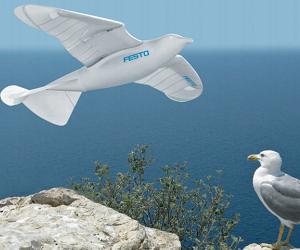Festo Built An Artificial Bird (video)

Share
The latest addition to the robotic zoo moves so gracefully you can hardly believe it's a machine. Festo's Bionic Learning Network has been creating robots based off of nature's biological secrets for years now, but their SmartBird is a step ahead of the game. Modeled after a seagull, the SmartBird uses a single drive system for flight - but that simple system is enough for the robot to take off, maneuver, and land autonomously. Using Zigbee radio communication, the SmartBird continuously passes information on its flight to an off-board computer that tracks, and improves, its movements. The result is a robot that seems to glide as smoothly and easily as the real thing. It's pretty amazing to watch it in action. Check out the SmartBird in the video below, followed by an animation that gives you a peak inside its frame. Festo's biologically inspired engineering may help catapult the field of robotics years ahead.
I've been impressed with the Bionic Learning Network before. They've built elephant trunk-like grasping arms, flying penguins, and floating jellyfish bots. Yet most of their previous flying machines have relied largely upon buoyancy to keep them aloft. While SmartBird is very lightweight (just 485 grams or so) it is definitely an example of powered flight. It's two meter wingspan and carbon-fiber hull give it's gentle flapping some significant lift. Yet that force is generated by a relatively small motor that moves a very simple drive system. Check out the animation below to see what I mean. Just a few gears to move both wings in motion. Very cool.
Be Part of the Future
Sign up to receive top stories about groundbreaking technologies and visionary thinkers from SingularityHub.


What makes the artificial seagull 'smart' is the controlled way in which its wings are pivoted as they flap. This allows the SmartBird to get an upstroke and downstroke almost identical to its organic inspiration using little power. The whole bot uses just 23 watts. The torsion applied to its wings also lets the bird steer, a feat which is monitored (and can be controlled) by external computers that communicate with the robotic gull via Zigbee radio. That means that not only did Festo engineers learn from nature to create the SmartBird, they can learn from the way SmartBird flies to create the next generation of robotic aircraft. A two meter seagull is a good start, but I can't wait until Festo has learned enough to create an artificial Pterosaur with a 10 meter wingspan. Or better yet, just build me a luck dragon. C'mon Festo, you know you want to.
[image and video credits: Festo]
[source: Festo Bionic Learning Network]
Related Articles

These Robots Are the Size of Single Cells and Cost Just a Penny Apiece

In Wild Experiment, Surgeon Uses Robot to Remove Blood Clot in Brain 4,000 Miles Away

A Squishy New Robotic ‘Eye’ Automatically Focuses Like Our Own
What we’re reading
